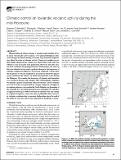Files in this item
Climatic control on Icelandic volcanic activity during the mid-Holocene
Item metadata
| dc.contributor.author | Swindles, Graeme T. | |
| dc.contributor.author | Watson, Elizabeth J. | |
| dc.contributor.author | Savov, Ivan P. | |
| dc.contributor.author | Lawson, Ian T. | |
| dc.contributor.author | Schmidt, Anja | |
| dc.contributor.author | Hooper, Andrew | |
| dc.contributor.author | Cooper, Claire L. | |
| dc.contributor.author | Connor, Charles B. | |
| dc.contributor.author | Gloor, Manuel | |
| dc.contributor.author | Carrivick, Jonathan L. | |
| dc.date.accessioned | 2018-01-04T10:30:30Z | |
| dc.date.available | 2018-01-04T10:30:30Z | |
| dc.date.issued | 2018-01 | |
| dc.identifier | 251872053 | |
| dc.identifier | 61798944-07a7-4b86-ad68-9f22d164ab6e | |
| dc.identifier | 85038837303 | |
| dc.identifier | 000418589600012 | |
| dc.identifier.citation | Swindles , G T , Watson , E J , Savov , I P , Lawson , I T , Schmidt , A , Hooper , A , Cooper , C L , Connor , C B , Gloor , M & Carrivick , J L 2018 , ' Climatic control on Icelandic volcanic activity during the mid-Holocene ' , Geology , vol. 46 , no. 1 , pp. 47-50 . https://doi.org/10.1130/G39633.1 | en |
| dc.identifier.issn | 0091-7613 | |
| dc.identifier.other | ORCID: /0000-0002-3547-2425/work/75996937 | |
| dc.identifier.uri | https://hdl.handle.net/10023/12424 | |
| dc.description | Watson acknowledges a Natural Environment Research Council–funded Doctoral Training Grant (NE/K500847/1). Cooper acknowledges a Leeds Anniversary Research Scholarship (Ph.D.) and a Climate Research Bursary Fund from the Priestley International Centre for Climate (University of Leeds). | en |
| dc.description.abstract | Human-induced climate change is causing rapid melting of ice in many volcanically active regions. Over glacial-interglacial time scales changes in surface loading exerted by large variations in glacier size affect the rates of volcanic activity. Numerical models suggest that smaller changes in ice volume over shorter time scales may also influence rates of mantle melt generation. However, this effect has not been verified in the geological record. Furthermore, the time lag between climatic forcing and a resultant change in the frequency of volcanic eruptions is unknown. We present empirical evidence that the frequency of volcanic eruptions in Iceland was affected by glacial extent, modulated by climate, on multicentennial time scales during the Holocene. We examine the frequency of volcanic ash deposition over northern Europe and compare this with Icelandic eruptions. We identify a period of markedly reduced volcanic activity centered on 5.5-4.5 ka that was preceded by a major change in atmospheric circulation patterns, expressed in the North Atlantic as a deepening of the Icelandic Low, favoring glacial advance on Iceland. We calculate an apparent time lag of ~600 yr between the climate event and change in eruption frequency. Given the time lag identified here, increase in volcanic eruptions due to ongoing deglaciation since the end of the Little Ice Age may not become apparent for hundreds of years. | |
| dc.format.extent | 4 | |
| dc.format.extent | 1876566 | |
| dc.language.iso | eng | |
| dc.relation.ispartof | Geology | en |
| dc.subject | QE Geology | en |
| dc.subject | Geology | en |
| dc.subject | DAS | en |
| dc.subject | SDG 13 - Climate Action | en |
| dc.subject.lcc | QE | en |
| dc.title | Climatic control on Icelandic volcanic activity during the mid-Holocene | en |
| dc.type | Journal article | en |
| dc.contributor.institution | University of St Andrews. School of Geography & Sustainable Development | en |
| dc.contributor.institution | University of St Andrews. Bell-Edwards Geographic Data Institute | en |
| dc.identifier.doi | 10.1130/G39633.1 | |
| dc.description.status | Peer reviewed | en |
This item appears in the following Collection(s)
Items in the St Andrews Research Repository are protected by copyright, with all rights reserved, unless otherwise indicated.

